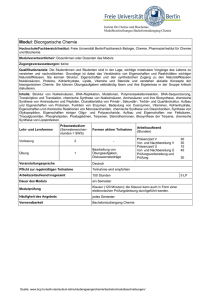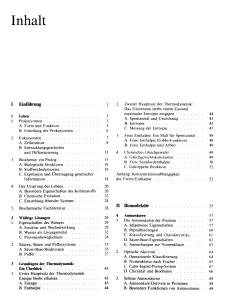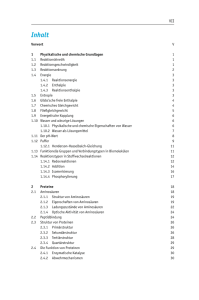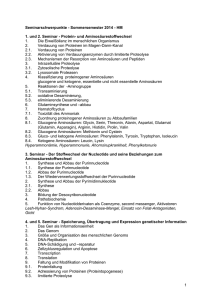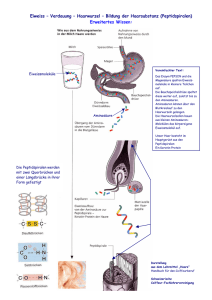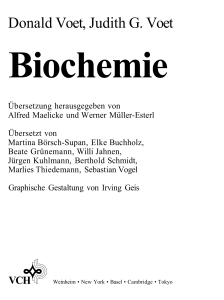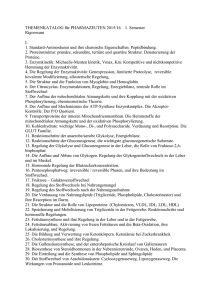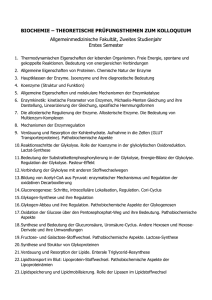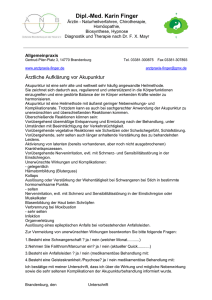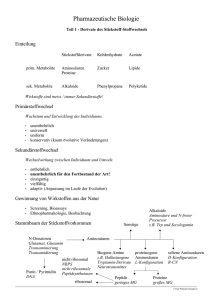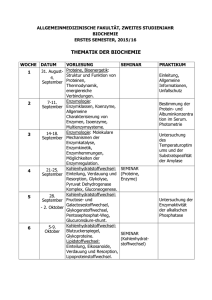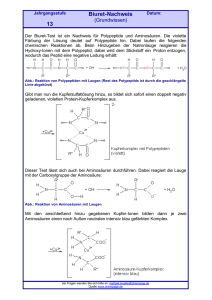Naturstoffchemie
Werbung
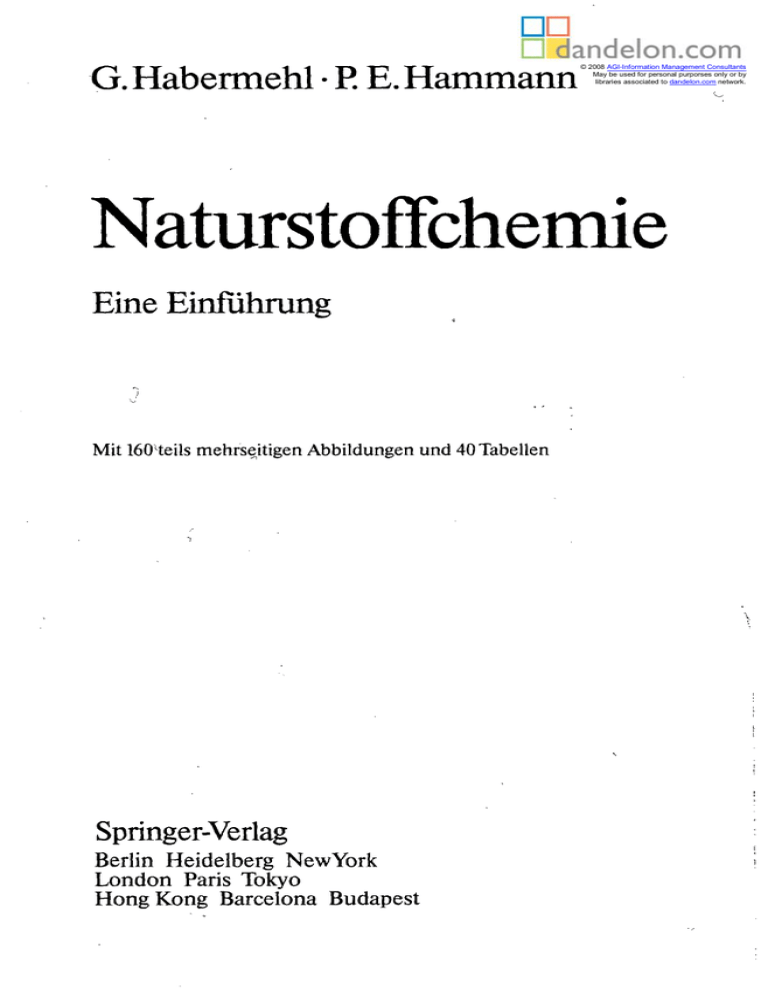
G. Habermehl • E E. Hammann © 2008 AGI-Information Management Consultants May be used for personal purporses only or by libraries associated to dandelon.com network. Naturstoffchemie Eine Einführung Mit 160lteils mehrseitigen Abbildungen und 40 Tabellen Springer-Verlag Berlin Heidelberg NewYork London Paris Tokyo HongKong Barcelona Budapest Inhalt Einleitung r 1 1. Terpene 1.1. 1.2. 1.3. 1.4. 1.5. " 1.6. 1.7. Monoterpene Sesquiterpene Diterpene Triterpene Tetraterpene Polyisoprene Biosynthese der Terpene 6 19 25 33 37 40 41 2. Steroide 53 2.1. 2.2. __2.3. 2.4. 2.5. 2.5.1. 2.5.2. 2.5.3. 2.6. 2.6.1. 2.6.2. 2.7. 2.7.1. 2.7.1.1. 2.7.1.2. 2.8. 2.9. Cholesterin und verwandte Sterole Steroidsaponine vom Spirostan-Typ Vitamin D Gallensäuren Corticoide Partialsynthese von Glucocorticoiden Partialsynthese von Mineralcorticoiden Derivatisierung von Cortisolacetat Sexualhormone : Gestagene und Östrogene Androgene Herzgiftglycoside Partialsynthesen von Cardenoliden Digoxigenin und Digitoxigenin Derivate des Digitoxigenins.: Bufadienolide Partialsynthese von Holothurinogeninen 5 54 62 64 67 70 71 81 83 84 85 98 99 103 104 111 115 117 X 2.10. 2.11. Biosynthese von Steroiden Steroid-Totalsynthesen 120 125 3. Biogene Amine und Alkaloide 143 3.1. 3.2. Biogene Amine Alkaloide mit Piperidin-, Pyrrol-, Pyrrolidinund Pyridin-Struktur Piperidin-Alkaloide Tropa-Alkaloide Coniin und verwandte Toxine Pyrrolidin und Pyrrol-Alkaloide Pyridin-Alkaloide Biosynthese der Alkaloide mit Piperidin-, Pyrrol-, Pyrrolidin- und Pyridin-Struktur Alkaloide mit Isochinolin-, Chinolin-, Chinazolinund Indol-Gerüst Isochinolin-Alkaloide Morphin-Alkaloide Chinolin-Alkaloide Chinazolin-Alkaloide Indol-Alkaloide Indolchinolizidin-Alkaloide Strychnos-Alkaloide >. Ergolin-Alkaloide Ellipticin-Gruppe Vinca- und Catharanthus-Alkaloide Biosynthese der Isochinolin-, Chinolin-und Indol-Alkaloide Alkaloide mit Indolizidin-, Pyrrolizidin- und Chinolizidin-Struktur Indolizidin-Alkaloide Pyrrolizidin-Alkaloide Chinolizidin-Alkaloide Biosynthese der Indolizidin-, Pyrrolizidinund Chinolizidin-Alkaloide Purin-Alkaloide Steroid-Alkaloide Solanum-Alkaloide Spirosolan-Alkaloide Holarrhena-Alkaloide Funtumia-Alkaloide Salamander-Alkaloide Veratrum-Alkaloide Batrachotoxine Biosynthese der Steroid-Alkaloide 143 3.2.1. 3.2.1.1. 3.2.1.2. 3.2.2. 3.2.3. 3.2.4. 3.3. 3.3.1. 3.3.1.1. 3.3.2. 3.3.3. 3.3.4= 3.3.4.1. 3.3.4.2. 3.3.4.3. 3.3.4.4. 3.3.4.5. 3.3.5. 3.4. 3.4.1. ^3.4.2. 3.4.3. 3.4.4. 3.5. 3.6. 3.6.1. 3.6.2. 3.6.3. 3.6.4. 3.6.5. 3.6.6. 3.6.7. 3.6.8. 152 152 159 163 170 172 173 180 180 190 192 197 199 200 212 213 218 220 221 227 228 235 239 241 242 245 245 249 252 252 255 256 261 267 XI 4. Aminosäuren, Peptide und Proteine 271 4.1. 4.1.1. 4.1.2. 4.1.3. 4.1.4. 4.1.4.1. 4.1.4.2. 4.1.5. 4.2. 4.2.1. 4.2.1.1. 4.2.1.2. 4.2.1.3. 4.2.1.4. 4.2.2. 4.2.2.1. 4.2.2.2. 4.2.3. 4.2.3.1. 42.3.2. 4.2.4. 4.3. 4.3.1. 4.3.2. 4.3.2.1. 4.3.2.2. 4.3.3. 4.3.4. 4.3.5. Aminosäuren Proteinogene Aminosäuren Nichtproteinogene Aminosäuren Analyse von Aminosäuren Darstellung von Aminosäuren Racemische Aminosäuresynthesen Enantioselektive Darstellung von Aminosäuren Biosynthese von Aminosäuren Peptide Peptid-Analyse Bestimmung der N-terminalen Aminosäure.... Bestimmung der C-terminalen Aminosäure Sequenzanalyse Spaltung von Disulfidbrücken Peptidsynthesen Aminosäurenschutzgruppen Verknüpfungsmethoden Biologisch aktive Peptide •. ^-Lactamantibiotika Peptidantibiotika Biosynthese von Peptiden Proteine Struktur und Klassifizierung von Proteinen Enzyme Enzymkinetik Mechanismus der Enzymkatalyse am Beispiel von Proteasen Anwendung von Proteinen Protein- und Peptidtoxine Modifizierung von Proteinen 271 272 278 281 284 284 287 295 297 297 299 300 300 302 302 303 305 310 316 326 331 332 333 338 340 344 349 350 353 5. Kohlenhydrate 359 5.1. 5.1.1. 5.1.2. 5.1.2.1. 5.1.2.2. 5.1.2.3. 5.1.2.4. 5.1.2.5. 5.1.2.6. 5.1.3. Monosaccharide Struktur der Monosaccharide Reaktionen der Monosaccharide Oxidation und Reduktion Aufbau und Abbau Osazonbildung Eliminierung und Epimerisierung Schutzgruppen für Monosaccharide Glycosidierungen Amino- und Desoxyzucker 359 360 365 365 369 372 373 374 377 388 XII 5.1.4. 5.1.5. 5.1.6. 5.2. 5.2.1. 5.2.2. 5.2.3. 5.3. 5.3.1. 5.3.2. 5.3.3. 5.3.3.1. 5.3.3.2. 5.3.4. 5.3.4.1. 5.3.4.2. 5.3.5. Cyclitole und Pseudozucker 393 VitaminC 400 Biosynthese von Monosacchariden, Glycolyse und Gluconeogenese ... 401 Di- und Oligosaccharide 409 Disaccharide 409 Aminoglycosidantibiotika 411 Glucosidaseinhibitoren 421 Polysaccharide 424 Homopolysaccharide 424 Heteropolysaccharide 428 Komplexe Polysaccharide 431 Glycokonjugate 431 Zellwandpolymere 432 Immunostimulantien aus bakteriellen Zellwänden 436 Glycopeptide 437 Glycolipide... 437 Synthese von Teichonsäuren 438 6. Nucleoside, Nucleotide und Nucleinsäuren 443 6.1. 6.hl. 6.1.2. 6.1.2.1. 6.1.2.2. 6.2. 6.3. 6.3.1. , 6.3.2. 6.3.3. 6.3.4. 6.4. Nucleoside in der DNA und RNA Chemische Synthese von Nucleosiden Nucleosid-Antimetabolite Natürliche Antimetabolite Synthetische Antimetabolite Nucleotide Nucleinsäuren Biologische Relevanz Chemische und physikalische Modifizierung von DNA und RNA DNA-Sequenzierung Oligonucleotid-Synthese Biosynthese von Nucleosiden 443 446 450 451 455 458 461 464 467 469 474 480 7. Porphyrine, Chlorine und Corrine 487 7.1. 7.1.1. 7.1.2. 7.1.2.1. 7.2. 7.2.1. 7.2.1.1. 7.3. 7.3.1. Porphyrine Synthese von Porphyrinen Häm und verwandte Verbindungen Totalsynthese von Mesoporphyrin und Hämin Chlorine Chlorophylle Totalsynthese von Chlorophyll a Corrine Vitamin B 12 489 494 503 506 512 512 514 521 521 XIII 7.3.2. 7.3.3. 7.4. Vitamin B12-Synthese und Orbitalsymmetrie-kontrollierte Reaktionen Vitamin B12-Synthese Biosynthese von Porphyrinen, Chlorinen und Corrinen 523 528 535 8. Lipide 545 8.1. 8.2. 8.3. 8.3.1. 8.4. 8.5. Fettsäuren Fette und Wachse Lipoide PAF ("platelet activating factor") Funktion von Lipiden beim Aufbau von biologischen Membranen Biosynthetischer Fettsäureaufbau und Fettsäureabbau 545 547 547 551 553 553 9. Eicosanoide (Prostaglandine, Prostacydine, Thromboxane und Leukotriene) 557 9.1. 9.2. 9.2.1. 9.2.1.1. 9.2.1.2. 9.2.1.3. 9.2.1.4. 9.3. 9.3.1. 9.3.1.1. 9.3.1.2. 9.4. 9.4.1. 9.5. Biologische Funktion Prostaglandine Synthese von Prostaglandinen Partialsynthese von PGE 2 und PGF 2a Totalsynthese von PGF 2a Chirale Vorstufen durch asymmetrische Diels-Alder-Reaktionen Dreikomponenten-Kupplung ' Prostacydine Synthese von Prostacyclinen und verwandten Verbindungen Synthese von PGI2 Synthese von Pyrazolo-Prostacyclinen Thromboxane Synthese von TXB 2 Biosynthese der Eicosanoide 560 561 561 561 564 567 568 573 573 573 574 578 578 580 10. Antibiotika und Chemotherapeutika 585 10.1. 10.2. 10.3. 10.4. 10.5. 10.6. 10.6.1. 10.6.2. 10.6.3. 10.6.4. Tetracycline Anthracycline Chloramphenicol Griseofulvin Polyether Makrolid-Antibiotika Erythromycine und verwandte Verbindungen. Polyen-Makrolide Ansa-Makrolide Ungewöhnliche Makrolide 586 588 591 592 593 600 600 603 604 607 XIV 10.6.5. 10.6.6. 10.6.7. 10.7. 10.8. Strategien zur Synthese von Makroliden Synthese von Elaiophyliden Avermectine und Milbemycine Endiin-Antibiotika Polyketid-Biosynthese 611 616 626 632 637 11. Pheromone 643 11.1. 11.2. Lepidoptera-Pheromone Coleoptera-Pheromone 643 649 12. Vitamine 659 12.1. Zusammenfassung der Vitamine 660 Sachverzeichnis 667
